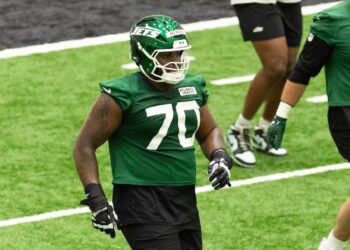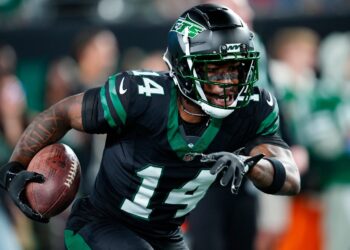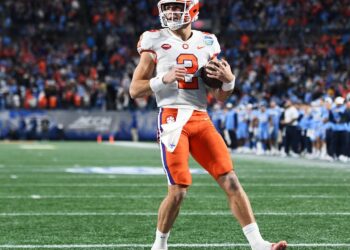Quarter(Black)s and W(hite) Receivers: Draft by Colors
by Tom Shane
Managing Editor

Last year, an NCAA quarterback led his team to an undefeated season, completing 70% of his passes while averaging close to 15 yards per completion: a smart guy with a strong arm–a coach’s son–quick on his feet, agile, a hard worker with classic size, classic quarterback mechanics. But Jason Campbell is not perfect. He’s a little stiff in the pocket and as a result he’ll take a bad sack every so often. He’ll get a little frazzled at times against tough defenses, but to his credit, he doesn’t throw bad interceptions. In last season’s undefeated campaign, some of his wins came against lollipop teams. These are some of the knocks on Jason Campbell. That, and he’s black.
It’s an old story–a boring one, not even worth telling. After all, three out of the twelve playoff teams last year had black quarterbacks. Two of them–Vick and McNabb– faced off in the NFC Championship Game. Daunte Culpepper is one of the most prolific passers, already, in NFL history; an unprecedented combination of arm strength and physicality. Steve McNair has been one of the great warriors of the game, playing through pain, carrying his team to the playoffs wearing a flack jacket and braces on both ankles. Michael Vick is lightning in shoulder pads; McNabb is perhaps the most complete QB in the game. There is no color-line anymore when it comes to picking QB’s. If you ask an NFL personnel man, they’ll tell you that they don’t care if a player’s skin is purple, as long as he can help you win games. However…
In 2004, there were no black quarterbacks taken in any of the seven rounds of the NFL Draft.
Including the ’99 draft, when McNabb, Akili Smith and Culpepper were taken in the first round, there have been 80 quarterbacks drafted. Only 18 of them were black. In 2003, it was two out of thirteen. In ’04, zero. This year, 2005, we could potentially see only two black quarterbacks drafted at all, Campbell and Florida State castoff Adrian McPherson. Unless someone takes a chance on Virginia Tech’s Bryan Randall or decides that Temple’s Walter Washington isn’t an H-back, it will be Campbell and McPherson out of a pool of nearly 15 QB prospects that will be drafted and given a chance to run somebody’s offense down the road. This is progress?

And then there was this wide receiver who showed up in Indianapolis for the Combine and laid down some insane numbers–size, speed, strength, quickness–that have never been seen before in the history of the stopwatch and scale. 6-foot-6″, 240 lbs., running a 4.37 in the forty. He dominated anybody they lined up in front of him in his drills, overpowering them at ease, out-running them without breaking a sweat. In fact, he wasn’t even really a wide receiver in college. He played quarterback. He played power forward on the basketball team. He’s quick, agile, tough–dominant. And even in spite of his enormous size, some personnel types would consider it a waste to play him at tight end–where Antonio Gates and Tony Gonzalez play–because this guy might be too athletic to put there. Too athletic to play the same position as Tony Gonzalez? In fact, nobody is really sure what to do with him. Is he a tight end? Is he a wide receiver? What he is is Matt Jones, a once-in-a-lifetime combination of size, speed and potential. And add to that, he’s white.
Like the black quarterback story, this one, too, is boring. Not even worth telling. The white athlete, trying to play wide receiver: Big deal. Is this even worth mentioning? We watched Ed McCaffrey for years burn the best cornerbacks in the league. Brandon Stokely, in alot of games, is the most dangerous player on the field for a Colts team that fields Peyton Manning, Reggie Wayne, Marvin Harrison and Edgerrin James. Our own Wayne Chrebet has been a model of toughness, grit and great hands for almost a decade with the Jets, practically re-defining the position of slot receiver in the NFL. So, the ‘white guy at wide receiver’ in the NFL is a non-issue. Right?
Starting from ’99, 74 wide receivers have been drafted on the first day of the NFL draft. Only two of them are white. One of those two was Eric Crouch, who quickly found his way out of the league.
In case you were wondering, Kevin Curtis, a promising, athletic slot receiver out of Boise State, is the other one; drafted in the third round in 2003 by Rams coach Mike Martz. When he drafted Curtis (perhaps a round or two too early), Martz was ecstatic, declaring that he’d make Curtis the best pass-catcher to play the slot position in the history of the league. Curtis has had mixed results doing that job, sometimes looking good, other times suffering through minor injuries. But Martz took a chance on the kid and it seems to be paying off. But the question now is, who will take that chance with Matt Jones?
The recent history of the draft tells us that somebody might make an athlete like Jones a first-round pick based on his combine numbers alone. Certainly, the measurables are there. However, if he doesn’t end up being a first rounder, the fact that he’s a white kid playing wide receiver won’t be his only undoing. Jones didn’t play wideout at Arkansas, instead demanding to be kept at quarterback where he only enjoyed moderate succes in the SEC. The mental and physical demands of playing the wide receiver position in the NFL will, no doubt, undo several athletes who have played wide receiver for a full four years in college. What can be expected of Jones, who only began lining up outside at the combine? Even still, it is hard to ignore the 4.37 forty-yard dash time, not to mention his potential to dominate in the red zone, where putting a receiver of his oustanding size out into the pattern could wreak havoc on opposing defenses.
Given all that, if Jones does come off the board where he’s currently projected–in the low first, high second round–Jones will become the highest white wide receiver drafted since Joe Jurevicius in 1998 (second round, #55 overall). Prior to Jurevicius, Rickey Proehl held the honor, getting drafted at #58 in 1990. No white wide receiver, post-1982, has gone higher than those two. What does that mean for Jones? It means that if Jones is drafted in the first round, it will break a racially-inscribed trend that has lasted longer than a quarter-century. What has taken so long?
The question that should be asked in both cases–that of Campbell and Jones–is, why? Why, in 2005, do these two talented players still have to overcome barriers concerning their race? Shouldn’t the NFL be past concerning itself with the color of an athlete’s skin and just allow his performance to speak for itself? There are and were great, Hall of Fame quarterbacks who happen to be black. Just the same, there are and were amazingly gifted Hall of Fame wide receivers who happen to be white. So why doesn’t the way NFL teams draft reflect this?
To answer my own question, it’s because the NFL, moreso than in any other sport, is a copy-cat league. Players are not drafted simply because of who they are, they are drafted because of whom they are compared to. Nobody drafts a “drop-back quarterback” anymore, they draft “the next Tom Brady.” Nobody drafts a “tall, fast wideout” anymore, they draft “the next Randy Moss.” As long as a player fits a certain mold, it will propel them straight up a draft chart faster than you can say Blair Thomas–excuse me–“the next Walter Payton.”
In the NFL, there is so much pressure to get to a Super Bowl in the mythical “three-year window,” that GM’s and owners cannot afford to take chances on thinking outside the box, drafting players who aren’t carbon copies of the player who won the Lombardi Trophy the year before. NFL franchises don’t take chances with coaches, and they certainly don’t do it with players. The NAACP and Jesse Jackson have been after the NFL for over a decade regarding what is perceived to be a racist hiring policy for head coaches and front office personnel. While the numbers support this assertion (as there exists currently less than a handful of minority NFL head coaches, and even fewer numbers of minority GM’s and owners), the explanation for this isn’t so easy as blaming it on a “Good Ol’ Boy Network” that excludes minority hiring. Old white coaches get recycled and new white coaches get hired repeatedly because GM’s and owners want what has worked in the past. For years, teams have fallen over themselves trying to out-bid each other for the Bill Parcells’s and Dick Vermeils of the world. Today, twenty years after the 49ers tremedous run, teams are still doing everything they can to hire the next great “Bill Walsh disciple.”
With players it is the same way. That is why no one drafts a white kid to play wide receiver in the first round. Despite the relative success of Steve Largent and Wayne Chrebet and Brandon Stokely, none of those guys could find a way to dominate the league like a Terrell Owens or a Randy Moss have. That is why, until the McNabbs and the Vicks and the Culpeppers of the world start winning Super Bowls consistently, a guy like Jason Campbell will get pushed to the second round, behind Tom Brady-types like Aaron Rodgers of Cal and Alex Smith of Utah.
And these models trickle down to the college game as well, perpetuating the limited schemes into which black and white players get pegged. In emulating the paradigms of successful NFL teams, the NCAA can only succeed in churning out more Tom Bradys and more Randy Moss/Marvin Harrison types. That is, until someone on the NFL level comes along and breaks the mold. If Donovan McNabb gets the Eagles over the hump and wins the next two Super Bowls, we will see more black quarterbacks get a shot in the NFL. If Matt Jones comes into the NFL and dominates the wide receiver position for a four to five year stretch, there will be an influx of white wide receivers into the NCAA, and then into the NFL.
The NFL is the ultimate “show me” league. It does not change much, and when it does, it changes slowly, methodically. Teams run certain offenses because those offenses worked at some point in the past. Martz’s ‘Fun and Gun’ in St. Louis is just a warmed-over version of the Chargers’ Air Coryell system from the late 70’s. Belichick’s masterful defensive game-plans are a melange of Buddy Ryan’s old ’46’ defense combined with Bill Arnsparger’s aggressive coverage schemes. In fact, it is a huge part of Belichick’s success that he recognizes that supposedly new offenses are just reincarnations of old offenses that he has been scheming against for thirty years. He runs the same defenses today against the mighty Peyton Manning-led Colts that he did almost twenty years ago against the Jim Everett Rams that he played against with the Giants. The more things change, as they say….
So what we have is not a racist league in the NFL, it is merely a league of imitators, of mimicry. There is no racially-fueled bias against the black quarterback or the white wide receiver, per se. There is merely the fear of not drafting the player-type who has done it before. GM’s need to draft a new player who looks old. They need to get a kid to do what a a man just did last January–win Super Bowls. There is no time for experimentation.
As I stated previously, it’s a boring topic–a non-issue. Not because the problem doesn’t exist–that players fly up and down a draft chart based solely on the color of their skin–but because the problem is easy enough to solve. All it will take is Matt Jones winning a few league MVP’s from the wideout spot, and for Jason Campbell to win a few Super Bowls at the quarterback slot (running Jack Pardee’s late-80’s Oilers run-and-shoot, no doubt), and you’ll have completely inverted the racial-stereotype drafting issue in the NFL.
Then, in twenty years, we can get together and discuss why no more white quarterbacks are being drafted into the league and why a black kid can’t get a shot at playing wide receiver in the NFL. And Belichick will still be running the ’46’ somewhere. You can count on that.









